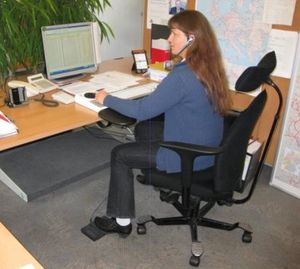KANBrief 1/18

Inclusive work design is part of a wider approach to safeguarding fitness for work. Owing to demographic change, this objective is becoming increasingly important. Technical measures for workplace design and accessibility are key aspects of this activity. They are implemented with the close cooperation and involvement of affected individuals and the elected representatives of the employees with severe disabilities.
The potential value of inclusive work design for safeguarding fitness for work is illustrated by the example of RWE, the power generation company. The concept of inclusive work design forms part of a toolkit for design of work in consideration of older and ageing people (cf. Buch, Draht, Gröner. Alternsgerechte Arbeit schafft Zukunftsfähigkeit. Conference paper, GfA-Press 2011). The toolkit was developed internally by the company, and contains further modules such as:
An essential characteristic of work systems that are geared to older and ageing employees is that they include all employees in work processes that are both productive and conducive to good health. At RWE, employees with a severe disability account for 11% of the workforce. Within the company, ergonomics is an important factor in retaining the fitness for work of employees with disabilities and reduced performance. Healthy ageing within the work process through to retirement age constitutes an objective that also serves as a yardstick for workers with reduced performance and disabilities.
Since 1996, over 1,500 interventions addressing inclusive work design and developed by the Ergonomics department have received funding, primarily from funds generated by the compensatory levy (paid by companies who fail to employ the statutory quota of disabled persons). The following features are characteristic of these interventions:
The technical design measures that have been implemented are correspondingly diverse. They include scissor elevating tables in workshops for the avoidance of unfavourable body postures; workpiece manipulators on lathes to make work less arduous; light and powerful tools for reduction of the physical effort required during maintenance work; software for reliable speech input; specially adapted IT hardware; and individ-ually optimized furniture for office work.
Vocational activity, and with it the tasks of work design, have changed fundamentally over the years (cf. Buch, Gröner, Bienias, De Jong. Inklusive Arbeitsgestaltung als Beitrag der Ergonomie für alter(n)sgerechte und effiziente Arbeitssysteme am Beispiel eines Energieversorgers. Conference paper, GfA-Press 2014). In the past, “sheltered” jobs were created that were characterized by less arduous work and a shift towards non-operative tasks for which performance was not critical. Such tasks were for example those of gatekeepers and pithouse shower attendants. These jobs are now generally either already being performed by persons with disabilities, or have been outsourced to third-party companies. The focus of work design measures therefore now lies upon enabling persons with severe disabilities and equivalent personnel being able to continue to perform their previous tasks.
Ease of access to the company’s administration buildings by persons with constrained mobility was determined by means of a checklist (cf. Buch, Gröner, Bienias, De Jong. Inklusive Arbeitsgestaltung als Beitrag der Ergonomie für alter(n)sgerechte und effiziente Arbeitssysteme am Beispiel eines Energieversorgers. Conference paper, GfA-Press 2014). At selected sites, accessibility was assured by construction measures (such as car parks, toilet facilities and ramps, with reference to DIN 18040-1).
The “Ergonomics Scouts” programme (cf. Gröner, Buch. Ergonomie-Scouts als Ausgangspunkt beteiligungsorientierter Arbeitsgestaltung. Conference paper, GfA-Press 2012) routinely implements the positive experience gained with employee participation. This intervention, originally developed for OSH professionals, was subsequently adapted for the representatives of persons with severe disabilities. The ergonomics scouts are trained in identifying the need for ergonomic design and ensuring that issues are addressed. They also monitor development and implementation of the measures. Through the approach involving ergonomics scouts, the established function of representatives for persons with severe disabilities was further consolidated in the company. Altogether, these representatives have a key function in the implementation of measures for inclusive workplace design.
Dr Markus Buch
markus.buch@rwe.com